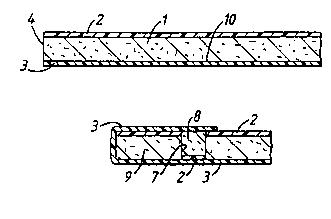Une partie des informations de ce site Web a été fournie par des sources externes. Le gouvernement du Canada n'assume aucune responsabilité concernant la précision, l'actualité ou la fiabilité des informations fournies par les sources externes. Les utilisateurs qui désirent employer cette information devraient consulter directement la source des informations. Le contenu fourni par les sources externes n'est pas assujetti aux exigences sur les langues officielles, la protection des renseignements personnels et l'accessibilité.
L'apparition de différences dans le texte et l'image des Revendications et de l'Abrégé dépend du moment auquel le document est publié. Les textes des Revendications et de l'Abrégé sont affichés :
| (12) Demande de brevet: | (11) CA 2183405 |
|---|---|
| (54) Titre français: | PROCEDE ET DISPOSITIF D'ETANCHEIFICATION A L'EAU DES BORDURES D'EBAUCHES |
| (54) Titre anglais: | METHOD AND APPARATUS FOR WATER-PROOFING EDGES OF BLANKS |
| Statut: | Réputée abandonnée et au-delà du délai pour le rétablissement - en attente de la réponse à l’avis de communication rejetée |
| (51) Classification internationale des brevets (CIB): |
|
|---|---|
| (72) Inventeurs : |
|
| (73) Titulaires : |
|
| (71) Demandeurs : |
|
| (74) Agent: | NORMAN M. CAMERONCAMERON, NORMAN M. |
| (74) Co-agent: | |
| (45) Délivré: | |
| (86) Date de dépôt PCT: | 1995-02-21 |
| (87) Mise à la disponibilité du public: | 1995-08-31 |
| Licence disponible: | S.O. |
| Cédé au domaine public: | S.O. |
| (25) Langue des documents déposés: | Anglais |
| Traité de coopération en matière de brevets (PCT): | Oui |
|---|---|
| (86) Numéro de la demande PCT: | PCT/IB1995/000113 |
| (87) Numéro de publication internationale PCT: | WO 1995023061 |
| (85) Entrée nationale: | 1996-08-15 |
| (30) Données de priorité de la demande: | ||||||
|---|---|---|---|---|---|---|
|
Un procédé de drayage consiste à réaliser par calandrage, le long de la zone de bordure d'une ébauche d'emballage (1-3) constituée d'une couche (1) absorbant les liquides en sandwich entre au moins deux couches (2, 3) constituant une barrière à liquide, une languette (8), une encoche (6) à l'intérieur de la languette (8), un talon (9) à l'intérieur de l'encoche (6) et une rainure (7) à l'intérieur du talon. Le procédé consiste ensuite à replier la zone de bordure pour introduire la languette (8) dans la rainure (7), et à étanchéifier la zone de bordure contre le restant du matériau en feuille, de préférence uniquement par pression mécanique.
A skiving method comprises forming by
milling, along an edge zone of a packaging blank
(1-3) comprised of a liquid-absorbent layer (1)
and at least two liquid-barrier layers (2 and 3)
thereon, a tongue (8), a recess (6) inwardly of
the tongue (8), a land (9) inwardly of the recess
(6), and a groove (7) inwardly of the land (9),
folding over the edge zone to insert the tongue
(8) into the groove (7). and sealing the edge zone
to the remainder of the sheet material, preferably
by mechanical pressure alone.
Note : Les revendications sont présentées dans la langue officielle dans laquelle elles ont été soumises.
Note : Les descriptions sont présentées dans la langue officielle dans laquelle elles ont été soumises.

2024-08-01 : Dans le cadre de la transition vers les Brevets de nouvelle génération (BNG), la base de données sur les brevets canadiens (BDBC) contient désormais un Historique d'événement plus détaillé, qui reproduit le Journal des événements de notre nouvelle solution interne.
Veuillez noter que les événements débutant par « Inactive : » se réfèrent à des événements qui ne sont plus utilisés dans notre nouvelle solution interne.
Pour une meilleure compréhension de l'état de la demande ou brevet qui figure sur cette page, la rubrique Mise en garde , et les descriptions de Brevet , Historique d'événement , Taxes périodiques et Historique des paiements devraient être consultées.
| Description | Date |
|---|---|
| Inactive : CIB expirée | 2017-01-01 |
| Inactive : CIB de MCD | 2006-03-12 |
| Inactive : Renseign. sur l'état - Complets dès date d'ent. journ. | 2003-04-29 |
| Inactive : Morte - RE jamais faite | 2003-02-21 |
| Réputée abandonnée - omission de répondre à un avis sur les taxes pour le maintien en état | 2003-02-21 |
| Demande non rétablie avant l'échéance | 2003-02-21 |
| Inactive : Abandon.-RE+surtaxe impayées-Corr envoyée | 2002-02-21 |
| Inactive : Demandeur supprimé | 1997-10-24 |
| Demande publiée (accessible au public) | 1995-08-31 |
| Date d'abandonnement | Raison | Date de rétablissement |
|---|---|---|
| 2003-02-21 |
Le dernier paiement a été reçu le 2002-01-28
Avis : Si le paiement en totalité n'a pas été reçu au plus tard à la date indiquée, une taxe supplémentaire peut être imposée, soit une des taxes suivantes :
Veuillez vous référer à la page web des taxes sur les brevets de l'OPIC pour voir tous les montants actuels des taxes.
| Type de taxes | Anniversaire | Échéance | Date payée |
|---|---|---|---|
| Enregistrement d'un document | 1996-10-03 | ||
| TM (demande, 3e anniv.) - générale | 03 | 1998-02-23 | 1998-01-27 |
| TM (demande, 4e anniv.) - générale | 04 | 1999-02-22 | 1999-01-19 |
| TM (demande, 5e anniv.) - générale | 05 | 2000-02-21 | 2000-01-25 |
| TM (demande, 6e anniv.) - générale | 06 | 2001-02-21 | 2001-01-25 |
| TM (demande, 7e anniv.) - générale | 07 | 2002-02-21 | 2002-01-28 |
Les titulaires actuels et antérieures au dossier sont affichés en ordre alphabétique.
| Titulaires actuels au dossier |
|---|
| ELOPAK SYSTEMS AG |
| Titulaires antérieures au dossier |
|---|
| LARS LYNGAAS |
| RAGNAR HARALD SAGVIK |